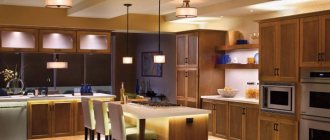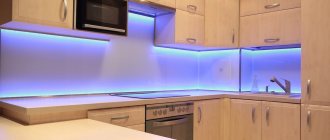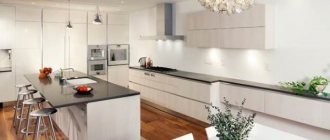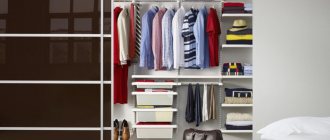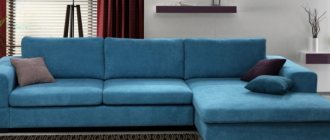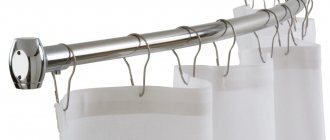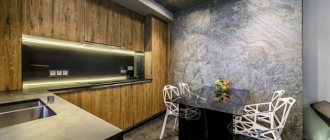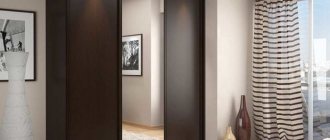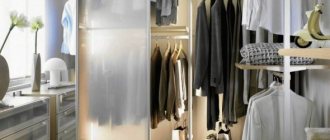The advent of LED strips has allowed modern designers to bring to life their most daring solutions. One of them is to make the work area in the kitchen fully comply with the regulatory requirements of SanPiN for lighting, and at the same time economical and beautiful. LED strips are precisely those elements that combine three important operational advantages at once.
LED strip for the kitchen under the cabinets
Recommendations for lighting placement
A kitchen set is a complex complex of many elements. Some of its sections are illuminated for technical purposes, others for decorative purposes.
To create uniform lighting, use the following techniques.
Kitchen lighting for cabinets - panels, lamps, slots. It illuminates the countertop, stove surface, and washbasin. The hostess perfectly sees everything that happens on her table.
Illumination of individual zones - used more often in a small kitchen. Here it is enough to illuminate the stove, sink and, for example, the area with the microwave, so that you can see the surface of the countertop. However, the first task of such lighting is localization.
Lighting on the top of wall cabinets - usually on a specially installed panel. Allows you to do without overhead ceiling lighting and even at dusk to see the contents of the cabinets.
Interior lighting of drawers . Allows you to see their contents: utensils, cutlery, dishes, small appliances.
Under-table lighting is an expensive and rare option. LED strip or lamps are mounted on the reverse side of the panel and you get luminous tabletops. To realize this idea, you need to install a surface made of translucent material or glass.
Illumination of glazed facades helps to see the contents of wall cabinets, but behind the glass facade all objects are already clearly visible. Low warm lighting - golden, pinkish light - creates an amazing atmosphere of comfort.
Illumination of the lower part of the headset - mounted on a plinth. Makes massive floor cabinets look airy. It seems that the kitchen does not touch the floor and floats.
For decorative lighting, it is allowed to use colored LEDs or lampshades. However, this solution is rarely resorted to. White light is enough to create a visual impact.
TOP 10 lamps for the work area
| Type of lamp | Model | Characteristic | price, rub. |
| Light-emitting diode (LED) panel | Gauss | 30x60 cm, 12 W, mounting type - overhead | 1370 |
| CD console | Uniel ULI-F 40 | Length 60 cm, 9 W, 4200 K | 1600 |
| LED corner lamp | Era LM 840-A1 | Touch switch, length 50 cm, 5 W, white light | 1780 |
| SD beam | Era LM 840-I1 | Motion sensor, length 50 cm, white light | 1530 |
| Built-in LED lamp | Uniel ULM F-40 | Dimmer, ø 8.5 cm, 4200 K | 1980 |
| Spotlight | GX 53 | Beam angle 120, 50 W, LED lamp, insert ø 60 mm | 50 |
| — | DL 1017 | — | 70 |
| — | GS-M394 | — | 150 |
| LED strip | LS SMD 3528-150-12 | Reel 10 m, DC 12 V, 4.8 W/m, cutting ratio - 3 LEDs, service life - 10,000 hours | 230 |
| CD trumpet | Maxus TB | 21 W, 220 V, length 1.5 m, ø 28 mm | 600 |
Linear backlight
The headset is illuminated using a variety of lighting fixtures. Based on their appearance, all options are grouped into 2 categories: linear illumination and spot illumination. The first involves the use of models from several radiation sources that form a single whole.
Fluorescent Lamp
The option that is least suitable for the definition, since it is an independent lighting device. However, its appearance is unusual - a tubular fluorescent lamp up to 1 m long or more. Installed under the upper cabinets along the length of the kitchen corner.
Pros and cons of fluorescent lighting
Very high luminous efficiency, so such lamps are considered the most economical way of lighting
Generates diffuse light
Operates from 2 to 90 thousand hours
Easy installation - installed on brackets on the bottom of wall cabinets
Flickering - if there is no choke, the lamp flickers and causes discomfort
Unsafe – the device contains mercury, must be disposed of after use
Generates an uneven line spectrum that is unpleasant to the eye
Works unstably at low temperatures, but in the kitchen this drawback does not matter
Only low pressure lamps are installed indoors.
Regular tubular fluorescent lamps are not beautiful. Special furniture options are available for installation on furniture.
LED panels
The safest option of all lighting methods. The LED device does not heat up; light is emitted not due to heating, but due to the work of the semiconductor - the basis of the device. The semiconductor generates directional radiation, but several sources are installed in the panel, and the entire plane is covered with a lampshade. The result is very uniform soft lighting that does not irritate the eyes.
LED panels can be installed on any flat surface: tabletop, furniture frame or wall, or the bottom of wall cabinets.
Pros and cons of LED panels
Long service life
Lamps do not flicker and do not irritate the eyes
The body does not heat up, so it is possible to place the panels directly on the furniture wall, and not on brackets
In terms of efficiency, LED lamps are second only to fluorescent lamps
The LED generates light of a precisely defined color temperature: not only white daylight, but also colored
Installation of LED panels is possible with your own hands
The need to dispose of lamps after use
High price
To illuminate the kitchen corner, it is advisable to use panels based only on white LEDs. If the device also serves a decorative purpose, color models are installed.
LED lights
The most popular option, as it is the most convenient to use. LED kitchen cabinet lighting is a flexible strip on which diodes are attached. When turned on, the semiconductors generate light, creating a bright strip of light.
Double-sided tapes are chosen for the kitchen. The diode strip is protected by a transparent plastic layer. It is completely sealed and can withstand direct contact with water. This tape can be placed directly on the washbasin.
If the tape is used to illuminate the interior of cabinets, you can use single-sided ones. This tape is protected on one side and is not airtight, but it protects the devices from dampness and dirt.
Open tapes with low IP ratings cannot be used in the kitchen.
An adhesive layer is applied to the tape on the reverse side, so installation is reduced to gluing the product in any convenient place. The connection is made only through a transformer, since the LED backlight operates on a direct current of 12 V, and not on an alternating current of 220 V.
Pros and cons of LED strips
Economical - the backlight consumes 7 times less energy than an incandescent lamp
Easy to install
Decorative – LEDs generate light of any color
The need to install a transformer and strictly follow the connection diagram
How to make a ribbon for furniture in the kitchen with your own hands
It is not difficult to make a backlight from an LED strip with your own hands. The installation looks like this:
- the protective strip is removed from the tape;
- the extreme contacts are cleaned and the cables are soldered;
- the connection is insulated using electrical tape or heat shrink tubing;
- LED strip is glued to a permanent place;
- the power supply is installed via an adapter (if there is a dimmer, it is also connected);
- The power supply is connected to the house wiring.
To illuminate the work area, it is better to choose an SMD5050 LED strip - it is bright and compact; for decorative lighting, you can purchase an SMD3528 strip. LED strip is sold in reels of 5 meters. The tape is first cut into pieces of the required length. The cut must be made according to the located marks, otherwise the device will not work. Some models do not have a soldered adapter; you will have to buy and solder it yourself.
Spot lighting
Spot lighting consists of small lighting fixtures, each of which is mounted separately. A row of lights above a table top is usually served by a single switch. The lighting of drawers or cabinets can be switched on separately. This is one of the biggest inconveniences when installing such lighting: the connection diagram is complex and requires laying a large number of cables. But this method allows you to place each lighting part exactly in the area where it is required.
Types of lamps
Illumination of wall cabinets is carried out using several types of lamps.
Built -in or mortise. Involves installing the housing into any surface. The cable is laid above the installation level. We don't see him. The body of the product is also hidden, only the lighting panel remains visible.
Overhead – the body remains visible, so the lamps themselves look more attractive. The device is fixed to any surface using brackets and glue. Can be stationary or rotary. The latter are more convenient, as they allow you to change the direction of the light.
The most convenient are overhead battery-powered lamps with Velcro for installation.
Types of lamps
A variety of lamps are used as lighting sources.
Halogen. They get very hot. They are only allowed to be placed on brackets and at a certain distance from the furniture.
Luminescent - economical, bright and very powerful, but they create an unpleasant flicker. With a short period of use, this drawback can be neglected.
LED – the biggest plus in this case is the size of the diode. The lamp can be really small in size and placed on any surface and even inside a box. LED devices do not heat up, emit uniform light at a strictly specified temperature and are only slightly less economical than fluorescent ones.
Choosing the optimal power supply
When creating lighting for kitchen cabinets, the need to purchase a power supply must be taken into account. The stability of the lighting depends on it, and when choosing this element, the recommendations of experts are taken into account:
- the power of this equipment should be within 25 percent, which is optimal when using an LED lamp or strip;
- It is advisable to purchase a model with a compact size, since it is quite easy to hide in furniture and is also easy to use;
- to turn furniture lamps on or off, you need a corresponding switch, and it can be push-button, touch or infrared;
- additionally, you need to purchase a dimmer, which provides easy control of the light flux, and its control can be mechanical or touch;
- a control unit is purchased if a multi-color ribbon is selected, so it ensures that the light flashes or shimmers in different shades.
Thus, when creating lighting, it is necessary to purchase not only the lamps themselves or the strip, but also some additional elements that ensure ease of control and regulation of lighting.
Recommendations for illumination and light temperature
Kitchen lighting is included in the overall kitchen lighting project.
This refers to the illumination of the worktop and equipment, as well as the upper part of the set. Lighting for drawers or cabinets from the inside can be installed regardless of the lighting level in the room. The general requirement for a kitchen is 150 lux per square meter . The requirement is the same for the dining and working areas. To calculate the required lamp power, determine the illuminated area - usually the worktops and stove - and multiply the value by 150 lux.
The result is divided by the number of lamps that are supposed to be installed. Based on the results obtained, lamps of suitable power are selected.
You also need to take into account the temperature of the light . This indicator determines the shade. For functional lighting, warm white light with a temperature of 2700 K is recommended, natural daylight - 4200 K, and cold light - 6400 K.
Warm light is recommended for a large kitchen, cold light for a small one, as such lighting visually expands the space.
Which switch will be more convenient?
Let's start with which option is better to refuse. The most impractical switches for lighting in the kitchen above the work area are those with motion sensors. As planned, they should be as comfortable as possible and turn on the light every time someone enters the room.
In fact, you don’t need to turn on the lighting every time, and the equipment works intermittently and can turn off while you are preparing something and practically not moving (for example, standing still while chopping).
Types of kitchen lighting.
But first, let’s answer the question, why do you need additional lighting in the kitchen?! First of all, this is necessary to make housewives much more comfortable cooking in the evening. Additional lighting will illuminate all corners of the kitchen unit, including its countertop. But when choosing lighting strips, it is important to give preference to moderately bright LEDs, otherwise the light will “hit” your eyes, thereby turning a comfortable time in the kitchen into real torture. It has long been proven that the most comfortable glow from the point of view of human perception is considered to be diffused light emanating from several lighting devices at once.
It is also impossible not to note the decorative part of using additional light; the fact is that cabinets in the kitchen can be illuminated solely to create a unique effect. Moreover, on sale you can find ribbons of completely different colors, ranging from red light to blue light. With such a variety, literally everyone can find the right shade for their kitchen.
Expert advice
If you do not have sufficient experience in electrical installation work, then it makes sense to listen to the recommendations of specialists:
- Connecting sections of tape is best done by soldering. This connection is much more reliable than connecting through connectors. The temperature of the soldering iron tip should not exceed 260°C;
- It is unacceptable to bend or twist the LED strip. If it is necessary to organize rotation, the tape is cut along the marks and connected through wires by soldering;
- Before installing the profile, the bottom of the cabinet should be cleaned of dirt and degreased;
- When gluing the tape, you should not immediately apply a lot of force. This will allow it to be re-glued if any flaws are identified;
- The power supply should be placed in an easily accessible place with good ventilation.
In addition, before testing, it would not be superfluous to once again verify the reliability of all electrical wire connections.
Installing an LED lamp will not cause serious difficulties if you first familiarize yourself with the features of the upcoming work. Subject to all rules and recommendations, even a novice electrician can ensure the safe operation of a lighting device.
What is LED
An LED is a semiconductor device capable of converting electrical current into light radiation.
The diode consists of a semiconductor located on a special substrate, a housing with contacts, and an optical system.
The main difference between an LED is that the process of converting current occurs immediately into light radiation. A well-designed circuit and assembly allow you to avoid any losses in the network. The pure color produced by LEDs has become a permanent design attribute.
Another plus is that the LED is low-voltage and therefore practically safe.
What LEDs look like
